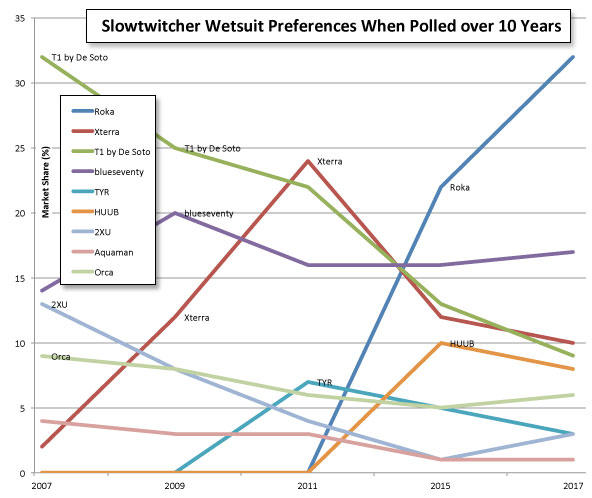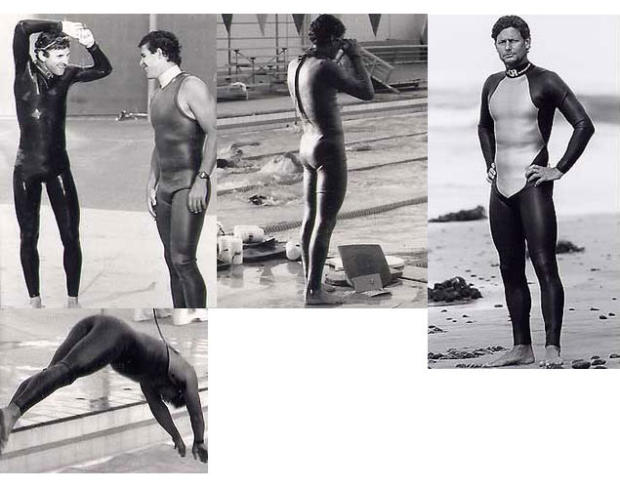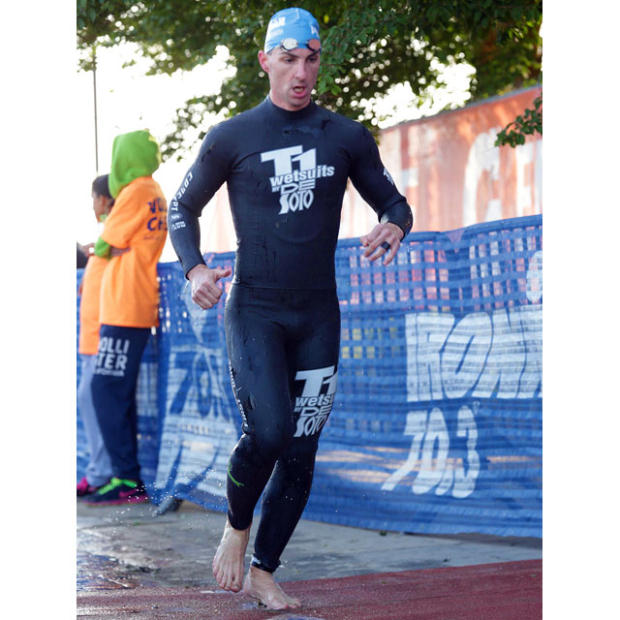blueseventy
This company in its various iterations has been making wetsuit for about 25 years. It started its life as Ironman Wetsuits, divesting itself of the Ironman name and changing it to blueseventy in 2005. There is no Ironman wetsuit today that I know of, though ROKA is an Ironman partner.
In my opinion the company today called blueseventy did not make particularly noteworthy products during its Ironman years. The year 2005 was a watershed not only because of the name change, but because the VO2 Stealth wetsuit (about which the company made, in my opinion, silly claims in the late 1990s) was replaced by the Helix. This new wetsuit model, the Helix, was a very good suit and it became a great wetsuit with its reworking in 2012. By 2012 I felt the Helix was the best 1-piece wetsuit made. Only the TYR Hurricane wetsuits were as fast, but the Helix was more durable, less fragile than the TYR.

That takes you through 2012. What about blueseventy in 2017?
The Helix
Perhaps the ROKA Maverick is a better suit. I don’t know. Perhaps Xterra makes suits that are every bit the equal of the Helix, or maybe even better. At a certain point it’s difficult to say: When wetsuits reach a certain quality level then it’s just the match between the suit and the user. Wetsuits are like running shoes: There is the list of capable footwear makers. All a running shoe (or wetsuit) company needs to do is make this list of capable brands. Once on the list, the needs of the user overwhelm everything else, and this determines which shoe (or wetsuit) on this short list is the user’s wisest choice.
The Helix has probably been the wetsuit most used most often by more wetsuit companies as a design touchstone for the apex of the craft. That established, the Helix is not the story for this brand in 2017. Yes, the Helix remains a great wetsuit, and one of the top 3 or 4 wetsuit models in the world. But blueseventy’s strength this year is in its down-market wetsuits. The Helix ($800) and the Helix Thermal ($850) are at the top of the heap. These models sit in the $700 to $900 price point, this price range indicative of each wetsuit company’s top performer (TYR’s $1,150 Freak of Nature is really a Freak of Commerce and can be discounted). Then you have a $500 threshold.
Downstreamed models
Let’s talk about this $500 level. In a future article we’ll overview this as a price point, and pick winners. blueseventy’s Reaction and ROKA’s Maverick Elite II are each in this category and each fares quite well. In fact, I like each one of these suits more than I like each company’s top-o’-the-line wetsuit if you consider value on the invested dollar. The Reaction and other downstreamed blueseventy suits start to peel away at the rubber thickness in strategic areas. The cheaper the suit, the thinner the rubber. This leaves blueseventy open to competitors’ suits that maintain 5mm rubber in flotation panels throughout.

But blueseventy counters this by keeping premium rubber in its suits. Chiefly this is Yamamoto #39 and #40 rubber. Other wetsuit companies are not using Yamamoto’s rubber. Blown rubber giants like Sheico may make rubber as good as Yamamoto’s rubber but if so they need to prove it to me. If Sheico wants to be considered a premier maker of rubber sheet goods I’m happy to hear the argument. Sheico knows where to find me. (Inside joke for those who are not Slowtwitch Reader Forum regulars.)
Rubber manufacturers (that do their customers no favors)
Having said that, neither Yamamoto nor Sheico nor any other rubber sheet manufacturer takes its case directly to the consumer. Shimano does. SRAM does. Profile Design, 3T, wheel and tire makers, all make the case for their products. Not rubber makers. As a wetsuit maker myself this used to really cheese me off. Why should I carry 100 percent of the water for my suppliers? (Yamamoto knows where to find me.)
The Fusion at $325 may be the best all-around value that blueseventy makes. It’s a Yamamoto SCS-coated suit which means flexibility and float along with durability and hydrodynamics. Yet again the thickness is peeled off a bit, but this suit still maintains strong flotation. The arms are made of 1.5mm-thick rubber. The patterns are good. I tried hard to make really good wetsuits for the 12 years I was in that business and I don’t think I ever made a suit any better than this one.

The Sprint is a $200 fullsuit. It’s very hard to make a $200 fullsuit these days. It’s near impossible to make it with Yamamoto SCS-coated rubber. But blueseventy has nevertheless done it. This suit’s obvious competitor is the Xterra’s Vortex, a $400 suit routinely available at $200. The Vortex has what the Sprint hasn’t: 5mm rubber (the Sprint’s rubber is 4mm thick). The Sprint uses rubber of a quality that may surpass that of the Xterra (Sheico knows where to find me).
This $200 fullsuit category is important. These are the wetsuits companies sell in droves in the week leading up to a big race. Xterra does very well in this category because of its expert ability to fulfill as a direct seller. blueseventy will do well because its retailers have the wetsuits right there, in town, you can try them on, retailers will be at the race expo.
When I poll Slowtwitchers here is what I find: There are three companies that rule all the others: Xterra, ROKA and blueseventy. Then there is the cult following for De Soto because of the unique and compelling virtue of the 2-piece. This is where the majority of the market is. Whether it should be here, that’s a good question and as I write about Orca, HUUB and the other companies we’ll talk about that.
Sales channels
One important question to be answered is the question of sales channel. If a brick & mortar retailer is going to remain a viable channel for wetsuit sales this channel must step up. It can’t try to sell from meager inventory. It must convince the manufacturer to adhere to a liberal return and exchange program, and in return for this the retailer must order wide and deep (in which case each side has proper protections). The retailer then must stand on top of its inventory and exchange when necessary.
When I owned and ran Quintana Roo here was my policy: a retailer could exchange any product I made for any other product I made. The retailer paid the freight back to me. No restocking charge. That was good until August 1, and the only goods that could be returned (beyond warranties and user-returned products) were new, current model inventory; and you couldn’t return goods as a way to pay your bill. The retailer could return bikes for wetsuits or vice versa. It could return wetsuits for a better size run distribution. It could return anything as a credit against the upcoming year’s delivery. It was shocking to me how few retailers took advantage of this very liberal policy.

Imagine this: You could buy 150 wetsuits from me (back then), sell 100, keep 20 as an inventory for later season purchases, and then send 30 back as a down payment against the next year’s inventory. Only one retailer would routinely do this with us (he was smart then and he’s smart now as a leading maker of triathlon saddles).
This kind of policy is important because, as with ROKA, blueseventy is liberal in its sizes. Also like ROKA this company doesn’t shortchange women. As well as I can tell there are actually more (9) womens sizes than mens (8) sizes.
Flotation schemes
One more thing! (And I find this interesting.) ROKA and blueseventy have precisely the opposite flotation and body position theories (see the schematic just above). They both have float panels interspersed with stretch panels. Just, Roka’s thickest, floatiest rubber is in the center panel. blueseventy’s center panel is thinner, and its thickest, floatiest rubber is to either side of the center panel. Each wetsuit’s scheme works, when considered as a system. What to make of this? I don’t know. I have to think this over some more.
Read more about blueseventy.







Start the discussion at forum.slowtwitch.com